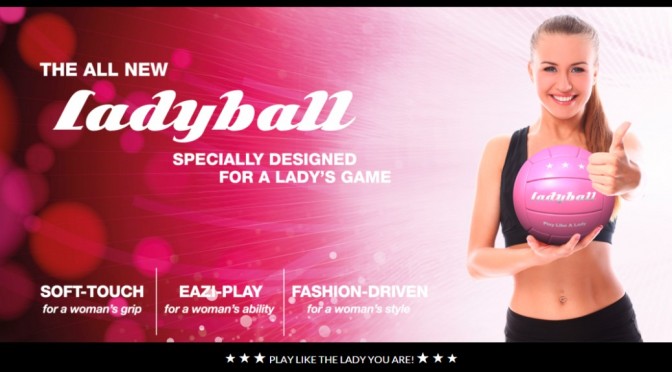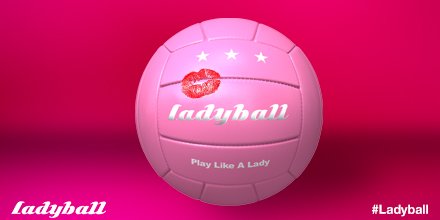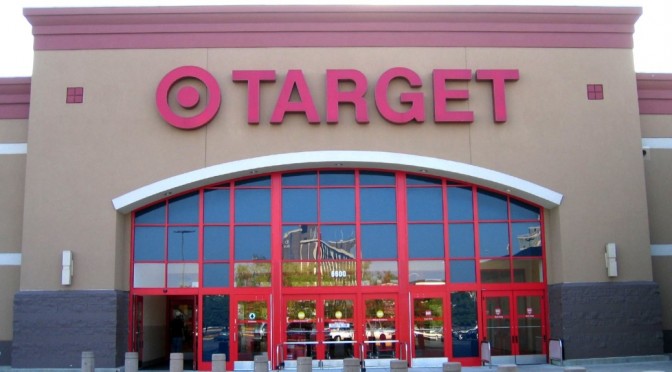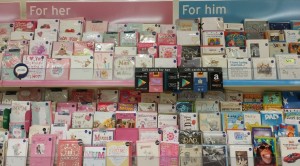Patronisingly Pink Ladyball for Women’s Football
Unbelievably, to encourage women in sport a pink sparkly soft-touch football is being marketed in a “pretty pattern that is designed especially for a woman’s grip”. Sigh! Women are more likely to be put off football by the sexism and homophobia in sport, unequal pay and media coverage, rather than the colour and texture of the ball!
Unless this is a major satirical spoof, it ticks every possible patronising pitch possible: “pretty” check, “pink” check, “sparkly” check, “soft” check, “easy” check, “glamorous” check!
Serious Proposition or Irish Joke?
It’s being made in Ireland, and it’s tempting to think that it is an Irish April Fool’s joke were it not January and endorsed by a real sportsman – Ger Brennan, an All-Ireland winning Gaelic Football player. Surely, it has to be a farcical fake designed to challenge rather than collude with sexism in sport?
In fact, their Twitter feed is full of jokes, disbelief, and amazingly, apparent appreciation. Lots of “ball” jokes and since one of the founders is female, a lot of poking fun at female stereotypes, or are they deadly serious?
What’s big, round & bouncy? #Ladyball pic.twitter.com/uc0IjaCrId
— Lady Ball (@theladyball_com) January 14, 2016
Their modern media, PR and advertising, seem to be everywhere in Ireland and yet their tagline soundbites are out of the pre-feminist dark ages:
“Don’t break a nail, break boundaries with #Ladyball” “Our ladies sure are pretty in pink! #Ladyball” “Ladies, the wait is finally over (&we don’t mean the one for the ring!) Introducing #Ladyball!” “Our pink #Ladyball has silver accents to help you sparkle on the pitch!”
Ladyball Official Launch Spec

From the Ladyball website comes this:
Ladyball is the concept led by a group of aspiring entrepreneurs who have made it their personal goal in life to encourage girls to play more team sports, and to bring a feminine touch to the all too masculine world of sports! The idea for Ladyball came from personal experience when one of the creators tried various ball sports as a weight loss measure and found the regular (or as we like to call them “man-sized”) balls heavy, cumbersome and difficult to control. It was then (as Oprah would say) she had an “aha moment”; what if there was a ball designed just for women, a soft, trendy ball that could enhance natural feminine abilities and make it easier for girls to play? After a lot of market research we found that there really wasn’t anything like that available, and in the majority of cases women just had to make do with balls meant for men. In order to fill this gap in the market and with the hopes of making team sports more accessible to women, the idea for Ladyball was born! Since that day we have spent countless hours researching and designing our creation. We want to revolutionize the way ladies play sports.
These women are kitted out in Ladyball’s branding but inappropriate footwear:
Keep your man(icure) longer with #Ladyball pic.twitter.com/heJof03uR1 — Lady Ball (@theladyball_com) January 14, 2016
Reaction on Twitter
Ladies want a “lady-ball” so they don’t break a nail, suggests a retweet by the makers:
Mandy just gets it. Our kinda gal x https://t.co/KM8HN1jP0T — Lady Ball (@theladyball_com) January 14, 2016
Yet other tweets still believe it to be a spoof or social experiment, one journalist received a press release and was stumped not to find a punchline at the end of what they assumed was a joke:
I just got a press release from #LadyBall and there’s, there’s no punchline. It’s a straight release. I am so terribly confused.
— Conor Pope (@conor_pope) January 14, 2016
Pink Balls
It’s not the first time pink balls have been introduced. Last November saw a premium game played with a pink ball and which led a male sports commentator to say:
“The pink ball is the prettiest, clearest projectile we have known. Its iridescence allowed superb pictures on television” – ESPN
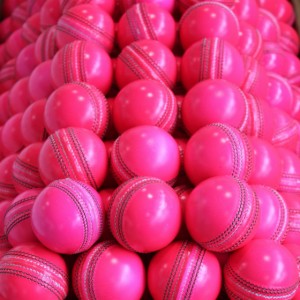
This was cricket, however, and male cricket at that! It was first introduced by Kookaburra in 2006 for a Cancer charity event but is now being used in some day-night matches for visibility. Mark Nicholas watching the Test at Australia’s Adelaide Oval went on to wax lyrical about the colourful aesthetics of the game:
“colours are an almost subconscious attraction – the way in which white clothing, for example, has such clarity against the green field and how a clear blue sky wraps itself so brightly around the canvas that the game creates.”
In cricket, at least, despite divided opinions, it is regarded as an innovation here to stay, but nothing to do with gender stereotypes.
Satire, PR Stunt or Sexist Stereotype?
It just, could be, that their advertising ‘genius’ is a girlie girl who loves sparkly pink. Just because pink is a female stereotype, doesn’t mean girls can’t be seen in pink, but to my mind this sets sports equality back years in perception, at least. The truth, if this is even true, will be whether it increases participation and gives the boot to received wisdom about women’s football. Not wanting to spoil the spoof or burst the ball of fun that this possibly serious-point making set-up appears to be, fact-checking flagged-up alarm bells and other mixed metaphors. Just trying to investigate their quoted ” patented Eazi-Play technology” drew a blank. Scottish football agrees although sees it as a hoax that “Highlights Discrimination in Sport” and “sexism in football. So, I call fake rather than foul, in this instance. Indeed, in the last few hours, Munster Hockey seem to have confessed to creating the challenge to sexist stereotypes, some assume an announcement about women’s sport is imminent and others are now doubting the spoof creator’s claims as just trying to get in on the act! It’s either a marketing marvel, comedy gold, or an unevolved sexist disaster. It just could be, the best advert for hockey yet:
The Munster Branch has this morning confessed to the creation of the Ladyball. We never expected it to get so much…
Posted by Munster Hockey on Friday, 15 January 2016
“we would like to apologise for nearly breaking the internet. However, we have been successful in making a very valid point. Men’s and women’s sport should be equal – same rules, same equipment and same goals. Hockey is one of the very few sports where men and women are on a par with each other in terms of coverage and recognition. So if anyone out there is looking to take up a sport that treats everyone as equal maybe hockey is the sport for you.”
Whether Munster Hockey were in on it or not, the @theladyball_com Twitter account has now also confessed to the ruse promoting women’s gaelic football (LGFA) along with Lidl sponsorship, “a lighting rod for the discussion of attitudes to women in sports and an amplifier for voices of support”.
The game is up. #Ladyball #SeriousSupport @lidlireland @LadiesFootball https://t.co/PysI14iq2A
— Lady Ball (@theladyball_com) January 15, 2016
